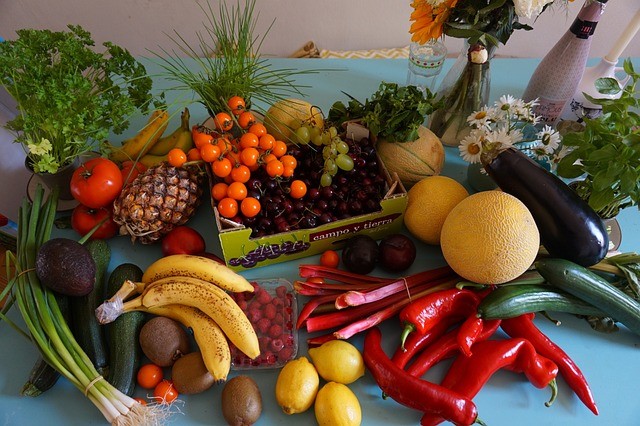Choosing seasonal fruit and vegetables can be tricky, but if you’re looking to add a touch of colour to your diet, what better place to start than with Mediterranean produce? And the I Love Fruit & Veg from Europe campaign is here to help with everything you need to know… whatever the time of year!
- Globe artichoke: Globe artichokes are both low in fat and low in carbohydrate and provide a good level of protein compared with other vegetables which tend to have values of less than 2%. They are high in folic acid and a source of potassium. They also provide useful levels of Manganese, Niacin and Magnesium. Globe Artichokes have been part of the gastronomic culture of the Campania Region in Italy for thousands of years and have both DOC and IGP status. The “Carciofo di Paestum” PGI artichoke, also known as “Tondo di Paestum”, from the name of the type from which it derives, is associated with the group of “Romanesco” type artichokes, known for the rounded appearance of its flower heads, their high compactness, and the absence of thorns in the bracts.
- Racula / Salad rocket: Racula or salad rocket is a peppery tasting green originating in the Mediterranean region. Low in calories, carbohydrate, and fat, it is packed with the following vital vitamins and minerals for good health – high in both Vitamin K and Folic acid and providing a source of calcium, Vitamin C, Vitamin A, and potassium. Its dark green sprigs are a super-distinctive salad ingredient with an oh-so-peppery bite. In particular the Piana del Sele rocket with its unique flavour and distinct aroma, has received the prestigious European IGP mark.
- Savoy Cabbage: is a winter vegetable and one of several cabbage varieties. It has crinkled, emerald, green leaves and is named after the Savoy region in France. It is high in both Vitamin C and Folic acid and provides a source of fibre, Vitamin A, and potassium.
- Basil: comes in many varieties, differing in size of the leaves to their fragrances echoing cinnamon or anise, even lemon. It adds colour and flavour to many dishes, particularly in Italian and Thai cuisine. Basil contains the antioxidants lutein and beta carotene, these carotenoids can protect us from disease and enhance our immune system. Basil is also high in the antioxidant Vitamins A and C as well as being high in calcium and Iron and providing a source of potassium.
- Parsley: often thought of as a garnish, parsley has so much goodness: both nutritional and in flavour, making it so much more than a decoration! There are two types of fresh parsley – curly leaf and flat leaf which has a stronger flavour. Parsley has many vitamins, minerals and antioxidants that can provide important health benefits. It is a particularly rich source of Vitamin K which is required by the body for blood clotting and helping wounds to heal. Parsley is also rich in Vitamins A and C, Folic acid and Iron and a source of calcium.
- Round lettuce: delicate in taste, texture and colour, it is the perfect gentle leaf for summer and famous for giving salads a base. Health benefits vary depending on the type of lettuce and a typical round lettuce, surprisingly, is a rich source of Vitamin K and a good source of Folic acid.
- Prickly pear: ranging in colour from green, which isn’t very sweet, to red, which is the sweetest. Yellow and red prickly pears tend to contain the most vitamin A and carotenes and they are also a source of vitamin C. In terms of mineral make-up, they are a source of magnesium and provide potassium and calcium. This unique variety of pear has both DOP and IGP protected status.
- Red orange (Blood orange): have a dark red flesh and less acidic, yet slightly sweeter taste than regular oranges. They are full of anthocyanins, responsible for their dark red colour and these antioxidants help the body reduce damage from harmful free radicals. They are also rich in vitamin C. The Sicilian Arancia Rossa also has both DOP and IGP protected status.
- Peaches: There are two varieties of peach, grown in two different regions of Sicily that have both been recognized by the European Union with PGI status. The Leonforte peach is cultivated with centuries old tradition and is a late season peach with yellow flesh. The Bivona peach is a velvety peach with creamy white flesh and slightly red veins. It is sweet with an unmistakeable scent, making it unique. Peaches are high in Vitamin C and provide useful amounts of Potassium and Vitamin K.
- Coscia pear: is an Italian variety of pear with creamy white flesh and a slightly scented, sugary flavour. They are low in calories, fat and provide us with fibre. They also contain useful levels of Potassium which helps regulate fluid balance, muscle contraction and nerve signals.
- Watermelon: invigorating and refreshing, watermelon provides a natural source of hydration. Its cheery red colour comes from lycopene, an antioxidant in the carotenoid family. Antioxidants protect the body from damage caused by compounds known as free radicals.
- Spring onion: high in levels of Vitamins C and K, both of which are essential for normal functioning of bones. Vitamin C helps in the synthesis of collagen that makes your bones strong, while vitamin K plays a key role in maintaining bone density. While some cuisines eat only the white part, and others eat only the green part, the whole wonderful length of the green onion is delicious in its own way: like having two vegetables in one!
- Kohlrabi: a bulb-shaped vegetable with a crisp, crunchy texture is part of the cabbage family. Less common in UK cuisine, it is high in both Folic acid and Vitamin C and contains a wide array of antioxidants such as anthocyanins, isothiocyanates and glucosinolates.
- Radish: the perfect vegetable to slice and add to a wide variety of salads, sandwiches or soups. A root vegetable with variable skin colour and an almost spicy, peppery taste. They are a good source of antioxidants like Catechin, Pyrogallol, Vanillic acid and other phenolic compounds. They are also a good source of Vitamin C, which acts as an antioxidant to protect against cell damage.
- Green and Red Lollo Salad: Lollo Rosso has more antioxidants than regular lettuce. It also contains Vitamins A and C and is a good source of both Folic acid and Potassium.
- Asparagus: a spear-like vegetable and member of the lily family, it is one of several vegetables that act as a prebiotic, feeding the beneficial bacteria which live in our digestive systems, helping them thrive and increase in number. It is a rich source of Folic acid and a good source of Vitamin C as well as providing useful levels of Vitamin E.
- Sweet chilli peppers: can be tasty, sweet, or super-hot too! These peppers contain the compound capsaicin, which gives them a distinctive taste as well as several health benefits. Their characteristic red colour is an indication that they are rich in beta-carotene or pro-Vitamin A. Vitamin A is key in maintaining healthy vision and a healthy respiratory, intestinal, and urinary system. Also, Vitamins A & C are vital in building up your immunity against infections and illnesses.
Discover more, plus plenty of seasonal recipe inspiration from I Love Fruit & Veg from Europe at: www.ilovefruitandvegfromeurope.co.uk.









